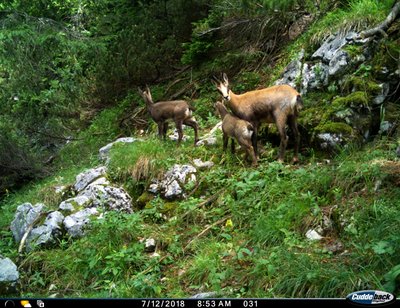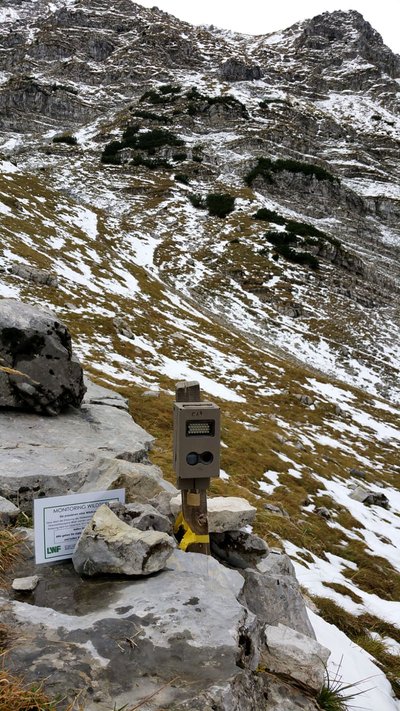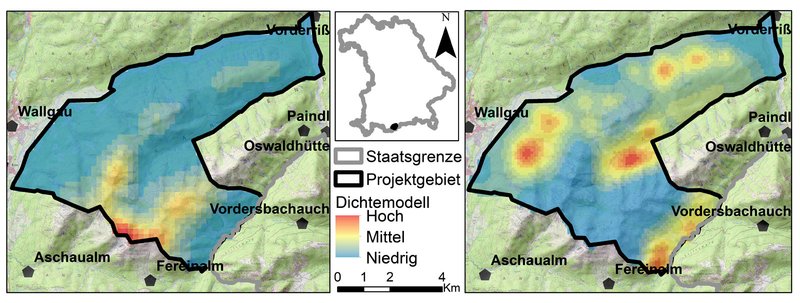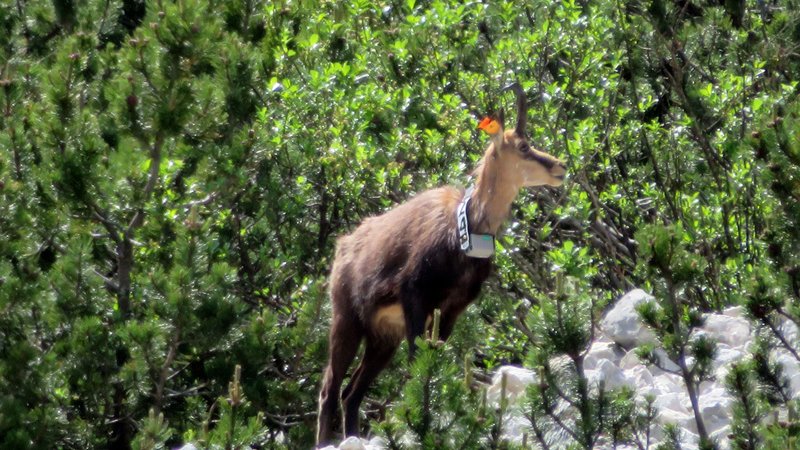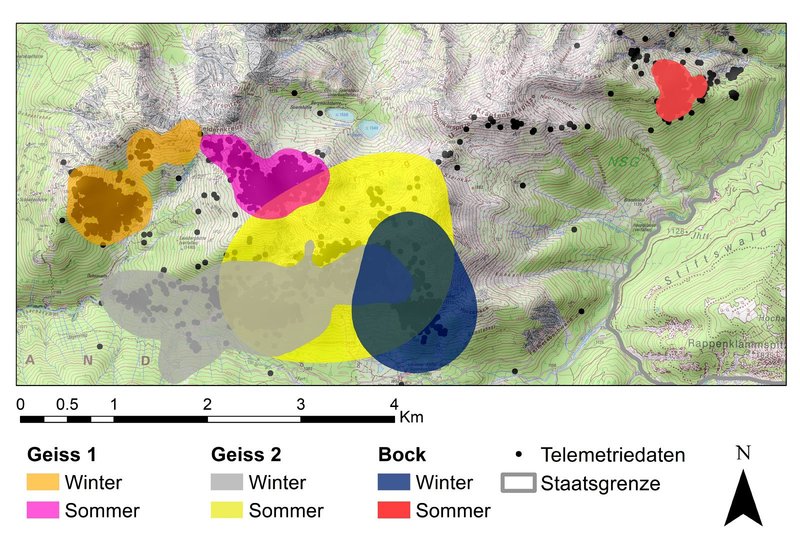Why was the research project on wildlife in mountain forests set up?
Mountain forests fulfil a variety of functions. They provide habitat for diverse plant and animal species, offer opportunities for recreation and sports activities, and are essential for certain economic sectors, such as forestry or agriculture. At the same time, mountain forests protect people from natural hazards such as avalanches, and protect forest soils from erosion and degradation. To ensure the functions of mountain forests can be performed in the long term, an adapted wildlife management concept is required. It should take into account the requirements of wildlife, the demands of society, and ecosystem functioning. In particular, this research project focused on the three ungulate species chamois, red deer and roe deer - all of which use the mountain forest and the adjacent areas as their habitat.
A goal-oriented management concept for chamois, red deer and roe deer in mountain forests should be best based on the findings of wildlife biological research. Among other knowledge, it is advantageous to know how many individuals occur in a particular area, which habitats they prefer to use, and how these biotopes are influenced by humans. This is why the Bavarian State Ministry of Food, Agriculture and Forestry (StMELF) has appointed the Bavarian State Institute of Forestry (LWF) to investigate these important relationships in a research project on “Integrative ungulate management in mountain forests”.
The research project was implemented in two Bavarian study areas; 1) in the foothills of the Karwendel mountain range, and 2) an area including the Geigelstein and Kampenwand mountains in the Chiemgau mountain range. In addition to traditional methods such as direct censuses, innovative methods including wildlife genetics, satellite telemetry and camera trapping (Figs. 1 and 2) are applied. Particularly important and unique is the approach chosen to focus on all three ungulate species relevant to the mountain forest simultaneously with the same methods. In this way it is possible to determine and analyse interrelations between the ungulate species and their habitat.
Chamois, red deer and roe deer live in the same area but use different habitats
Collecting reliable and robust information on wildlife, especially in closed habitats, can be difficult. Even in times of modern technology, one challenge remains determining population size in a predefined area and their structure. In this study, fresh faecal samples were collected and subsequently genetically analysed to estimate population densities, sex ratios and the spatial distribution of the wildlife in the two study areas. During genetic analyses each sample could be assigned to a specific individual and its sex identified. This allowed statistical evaluations to calculate the populations and to determine in which areas the lowest and in which the highest population densities occur.
The results showed heterogeneous densities and distributions within the sampled areas (Edelhoff et al. 2023). In autumn, for example, chamois in the “Karwendel” area occurred above the timberline in significantly higher densities than in the intermediate altitudes; in the lowlands they were largely absent (Fig. 3). On the other hand, the areas with the highest densities of red deer concentrated at lower altitudes than those of chamois at this time of the year. There were thus only a few areas where both ungulate species occurred simultaneously in high densities. According to the estimates, there were about 1,000 chamois and approximately 340 red deer in the study area of approx. 5,500 ha. In the case of roe deer, the faecal samples found were not sufficient to be able to derive reliable estimates.
For autumn in the “Karwendel” study area, the investigation of the habitat use of the three ungulate species also revealed considerable differences in their preferred habitat characteristics. It emerged that chamois prefer steep and rugged terrain, while red deer tend to seek out more level terrain with gentle slopes in or near forests. Roe deer occurred in habitats with high cover at lower altitudes at low densities in the “Karwendel” study area. Compared to chamois, habitat suitability for red deer was more strongly influenced by the availability of vegetation, such as a high proportion of rejuvenation in the forest vegetation. With regard to human disturbance, it was noticeable that chamois kept the shortest distance from hiking trails of all three ungulate species, while red deer avoided hiking trails the most. These results provide insights into the influence of human activities on ungulate species, and thus represent important components for integrative wildlife management.
Telemetry provides detailed insights into the movement patterns of chamois
Increasing human presence in mountain regions, through tourism, sport and hunting activities, exposes chamois to a variety of direct and indirect human influences that potentially limit habitat suitability. These complex interrelationships and the associated management of the chamois are increasingly subject of public concerns. However, there has been little research to date into the spatio-temporal behaviour of chamois in the Bavarian Alpine region, so that there is currently little robust empirical data to substantiate these discussions scientifically. As a result of the increased interest in chamois as a characteristic wildlife species of the Bavarian Alpine region, the initial project on ungulates was extended to include an additional module on “Spatio-temporal habitat selection of chamois in Bavaria”.
Satellite telemetry collars generate movement data with high spatio-temporal resolution. These data can provide detailed insights into the behaviour of chamois and in combination with other data measured at the same time at the same location, such as forage availability, intensity of human influence, or weather conditions, determinants for chamois movement behaviour can be derived.
First observations of tagged chamois (Fig. 4) show that their seasonal movements are highly variable. For example, Fig. 5 shows the summer and winter ranges of a chamois buck and two chamois does. While the buck has a very small summer range and migrates in winter to a separate winter range about 6 km away, the two chamois does occupy less clearly differentiated seasonal ranges. This variability in their movement patterns and space use allows chamois to adapt to seasonal changes in their habitat. The additional project component on “Spatio-temporal habitat selection of chamois in Bavaria” is supported using funds from the Bavarian hunting tax revenue.
Outlook for further research activities on the wildlife in mountain forests
These research projects contribute to the development of a comprehensive and scientifically reliable pool of knowledge on wildlife and their habitats in a cultural landscape. The focus is on the state of our ungulate populations and the interrelationships between the wild animals and the various different human uses of the area.
The next step is to compare the habitat use of the three ungulate species with human land use. For this purpose, the different types of land use by agriculture, forestry, hunting and tourism in the study areas are being recorded. The comparison of the use of space by humans and wildlife should allow identification of conflicts and open up possibilities for the development of mitigation strategies. These and the results of other wildlife research are elementary components and scientific basis for an integrative wildlife management concept that also considers interests of all stakeholders.

